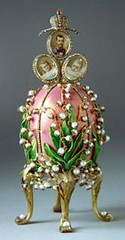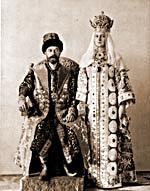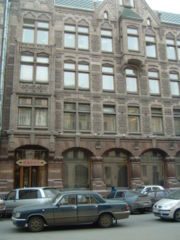
PREV ARTICLE
NEXT ARTICLE
FULL ISSUE
PREV FULL ISSUE
LONG-LOST FABERGE CONTRAPTION DISCOVERED It's non-numismatic, but I know this will interest many of our readers, as it did me. Back during my stint in London I had some enjoyable dinner conversations with John P Andrew, Coin World's London correspondent. I learned that in addition to coins, he is also an expert on silver art and the works of Peter Carl Fabergé. It's non-numismatic, but I know this will interest many of our readers, as it did me. Back during my stint in London I had some enjoyable dinner conversations with John P Andrew, Coin World's London correspondent. I learned that in addition to coins, he is also an expert on silver art and the works of Peter Carl Fabergé. Russian jeweler Fabergé (1846–1920) was best known for the famous Fabergé eggs, made in the style of genuine Easter eggs, but using precious metals and gemstones rather than more mundane materials. I thought John had had one too many drinks when he relayed the account of an unusual machine Fabergé built to speed the manufacture of his precious eggs. But the machine held a secret.  Under growing scrutiny by competitors jealous of his close ties to the Czar and his family, Fabergé decided to pull one over on them. Not wishing to divulge even the most mundane steps of his manufacturing process, he hid them within a glorious contraption he demonstrated on rare occasions to selected visitors to his store in St. Petersburg. Silver, gold, diamonds and rubies went in one end, and after over an hour of tapping, clanging and hammering, out popped a fabulous Fabergé egg from the other end. Under growing scrutiny by competitors jealous of his close ties to the Czar and his family, Fabergé decided to pull one over on them. Not wishing to divulge even the most mundane steps of his manufacturing process, he hid them within a glorious contraption he demonstrated on rare occasions to selected visitors to his store in St. Petersburg. Silver, gold, diamonds and rubies went in one end, and after over an hour of tapping, clanging and hammering, out popped a fabulous Fabergé egg from the other end. Fabergé's contraption was secretly modeled after the famous Mechanical Turk, a machine designed by an Austrian tinkerer and scientist in the late 1700s - a time when machines that could simulate some aspect of life were apparently all the rage at Europe’s courts. On the more charming side was a boy playing the flute, whose wind-up gears actually produced a flute-like sound. On the less charming side was a replica of a duck, whose primary enchantment was that when fed, his wind-up gears took the food through the process of digestion, including the excretions at the end. Fabergé's contraption was secretly modeled after the famous Mechanical Turk, a machine designed by an Austrian tinkerer and scientist in the late 1700s - a time when machines that could simulate some aspect of life were apparently all the rage at Europe’s courts. On the more charming side was a boy playing the flute, whose wind-up gears actually produced a flute-like sound. On the less charming side was a replica of a duck, whose primary enchantment was that when fed, his wind-up gears took the food through the process of digestion, including the excretions at the end. The mechanical Turk was far more impressive than any other machine of its day, because it seemed to be able to think. The machine was a large table, which housed the machine’s gears, and the figure of an Ottoman Turk. What the machine did was to play chess, very, very well. Onlookers were astonished, but in the end it was all a hoax - hidden inside the "machine" was a master chess player, manipulating the arms and hands of the Turk. Inside Fabergé's machine, hidden from view, was a midget master jeweler who assembled the eggs from an array of partially completed components. Although there were many skeptics, Rasputin quelled them, implying that the work of the devil was somehow involved. Most thought it best not to question, although some wags called the contraption "Fabergé's Chicken".  Well, to bring the story to the present, a Russian newspaper reported this week that during the demolition of Fabergé's former store building in St. Petersburg, workman found a set of crates in an attic storeroom that appear to contain the complete workings of the machine. The Hermitage Museum has hired a team of top mechanical engineers and craftsmen to reassemble it for a new exhibit on Fabergé scheduled to open in 2011. Well, to bring the story to the present, a Russian newspaper reported this week that during the demolition of Fabergé's former store building in St. Petersburg, workman found a set of crates in an attic storeroom that appear to contain the complete workings of the machine. The Hermitage Museum has hired a team of top mechanical engineers and craftsmen to reassemble it for a new exhibit on Fabergé scheduled to open in 2011.To read the original article, see: Now We Know Which Came First: Fabergé Chicken Found in St. Petersburg Building (http://www.pseudology.org/Bank/Faberge.htm) Wayne Homren, Editor The Numismatic Bibliomania Society is a non-profit organization promoting numismatic literature. See our web site at coinbooks.org. To submit items for publication in The E-Sylum, write to the Editor at this address: whomren@gmail.com To subscribe go to: https://my.binhost.com/lists/listinfo/esylum All Rights Reserved. NBS Home Page Contact the NBS webmaster 
|